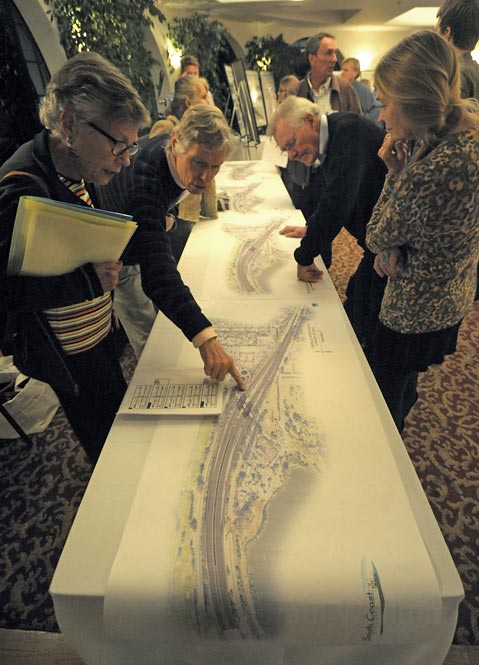Montecitans Debate Exit Strategy
Caltrans Proposes Carpool Lanes for 101
“It’s like kindergarten,” said Paul McClintic, a Caltrans traffic operations employee, of proposed carpool lanes that would run from Santa Barbara to Carpinteria — where six lanes bottleneck into four in both the north and south directions — and eventually all the way down to L.A. “You get to cut in front of the line.”
McClintic was one of the participants in a meeting hosted by Caltrans at the Montecito Country Club on Tuesday evening to inform the public about the South Coast 101 High Occupancy Vehicle (HOV) Lanes Project, which would add carpool lanes that only motorcycles, buses, and cars with two or more passengers would be allowed to travel.
The cost of the project is estimated to be between $345 million and $455 million. The Santa Barbara County Association of Governments has committed $22 million from gas tax and bond funds while another $140 million is available from the Measure A transportation sales tax. The rest of the money would have to be wrangled from state and federal sources.

Project manager Scott Eades said one of the goals of the project was to solicit as much community input as possible. So Montecito residents pored over scale maps and talked to Caltrans employees stationed around a meeting room to answer questions.
The HOV lanes — one in each direction — would only be part-time, possibly but not definitely from 6-9 a.m. and 3-6 p.m. The rest of the time, any vehicle would be allowed to use them. They would also be accessible in any location (separated by a dashed white line), which is more typical of HOV lanes in Northern California rather than Southern, where carpool lanes are separated by a double yellow line and can only be entered into and exited from in specific locations.
Adding carpool lanes will necessitate moving the Sheffield and Cabrillo exit ramps to the right side of the freeway and reconfiguring the interchanges. While the majority of the residents did not object to the addition of HOV lanes in principle, they had strong feelings about their implementation.
“Our biggest sadness was that the left-hand exits were closed,” said Sybil Rosen, who lives on Hermosillo Road. They help keep traffic away from residential areas and Coast Village Road, she said.
Eades explained that both state and federal highway agencies are trying to eliminate left-hand exits for safety reasons, and crossing over an extra carpool lane would only make matters worse. Caltrans has drawn up five different alternatives for the location of ramps in Montecito.
Residents who live on or near Hermosillo are worried that their neighborhood will get congested with traffic headed to the beaches and downtown Montecito. They say that the trucks servicing downtown businesses already speed through their streets. Therefore, they tend to favor having a Hermosillo exit and one shortly thereafter that leads to Coast Village Road, while residents in the Upper Village seem to favor a single exit ramp in order to minimize environmental impacts.
During a question-and-answer session with Eades, residents raised concerns about disruptions that will be caused by the construction, saying that the closures during the Milpas-to–Hot Springs lane expansion created a traffic nightmare. They also asked about sound barriers and air pollution, but despite their worries, they shouted down a fellow audience member when she tried to hijack the floor from Caltrans staff to rail against the project.
After the question-and-answer session, Montecitan J’Amy Brown said, “I think we have a Caltrans that does listen to the taxpayer.” There is another informational meeting scheduled today, November 17, from 5:30-8 p.m. at QAD Inc., 100 Innovation Place in Montecito. Caltrans expects to hold public hearings in March or April 2012 after a draft environmental impact report is completed.



